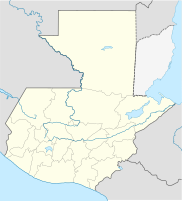San Agustín Acasaguastlán
| San Agustín Acasaguastlán | ||
|---|---|---|
|
Coordinates: 14 ° 57 ′ N , 89 ° 58 ′ W San Agustín Acasaguastlán on the map of Guatemala
|
||
| Basic data | ||
| Country | Guatemala | |
| Department | El Progreso | |
| Residents | 34,343 (2002) | |
| Detailed data | ||
| surface | 358 km 2 | |
| Population density | 96 inhabitants / km 2 | |
| height | 297 m | |
| Waters |
Río Motagua Río Hato |
|
| Time zone | UTC −6 | |
San Agustín Acasaguastlán (formerly San Agustín de la Real Corona) is a small town with around 8,000 inhabitants and a municipality in the Department of El Progreso in Guatemala . It is located around 90 km northeast of Guatemala City and around 20 km northeast of Guastatoya in the valley of the Río Motagua at an altitude of 297 m. A few kilometers south of the village, the important CA 9 Atlantic highway runs along the Motagua.
The 358 km² municipality extends between the Sierra de las Minas in the north and the valley of the Río Motagua in the south. It has a total of about 36,000 inhabitants, the majority of whom live in smaller rural settlements and villages, including El Rancho (where National Road 17 branches off the Atlantic trunk road to the northern Verapaz region), Tulumajillo (on the N 17 & CA 14), Magdalena, Puerta de Golpe, El Cimiento, Montaña La Juana, Las Delicias and El Aguacate.
Adjacent municipalities are San Cristóbal Acasaguastlán in the east, El Jícaro and Guastatoya in the south and Morazán in the west. In the north it borders on the departments of Baja Verapaz and Alta Verapaz .
In neighboring San Cristóbal Acasaguastlán was the religious center Acasaguastlán. It was of great importance for Mayan ethnic groups who politically belonged to Copán and Quiriguá (probably Pocomam ). During the colonial period, the area around Acasaguastlán formed an administrative district of the same name ( corregimiento ), from which the two municipalities of San Cristóbal Acasaguastlán and San Agustín Acasaguastlán emerged. In both places, worth seeing churches in the baroque colonial style remind of the Spanish rule. Both were badly damaged in the 1976 earthquake, but were restored.
In the area of the municipality of San Agustín Acasaguastlán there are the two small Mayan ruins Guaytán and San José Apantes. San Agustín Acasaguastlán is located in a very dry area on the Río Hato (also "Río Lato"). Thanks to systematic irrigation , the place is known for its agricultural products and is also called "the vegetable garden".
